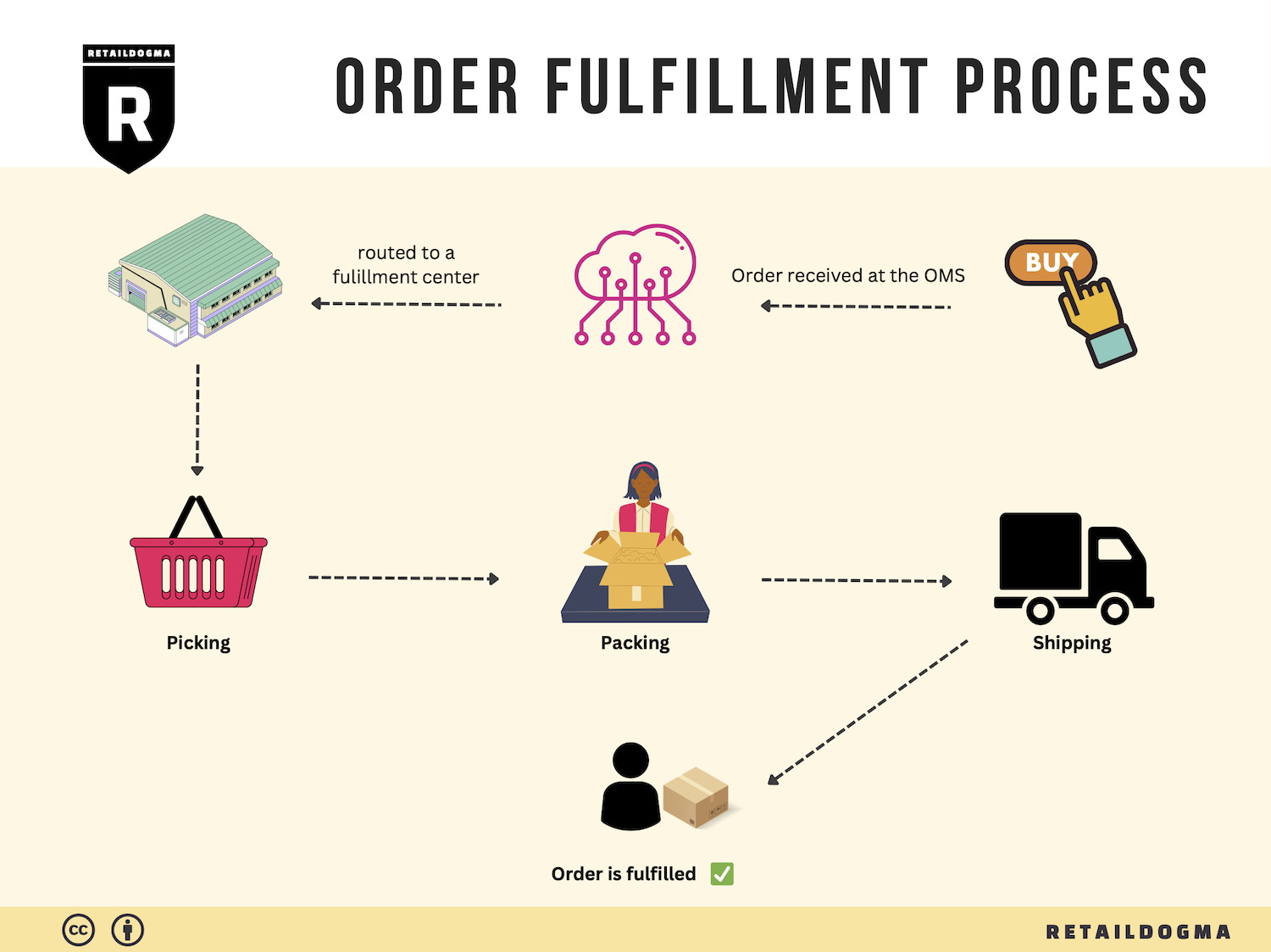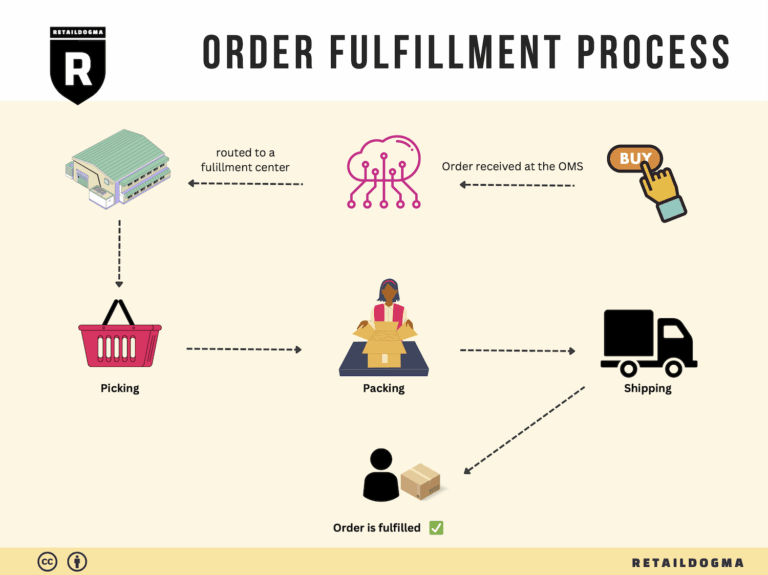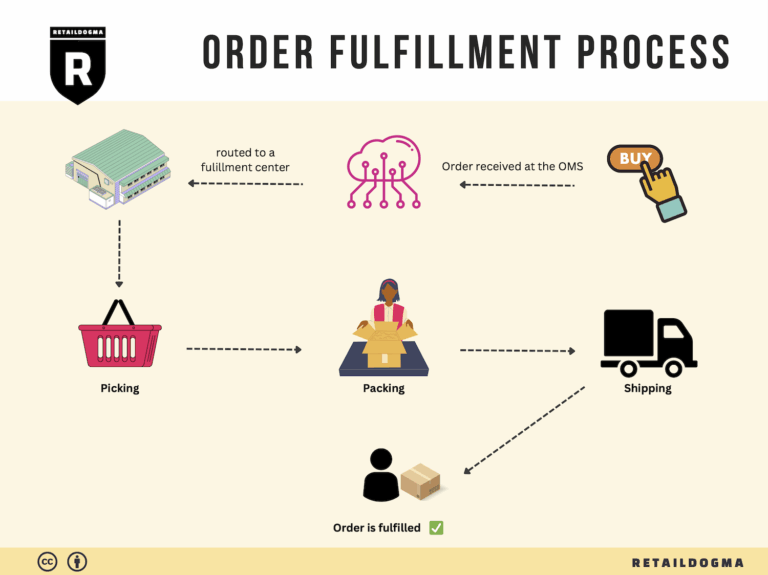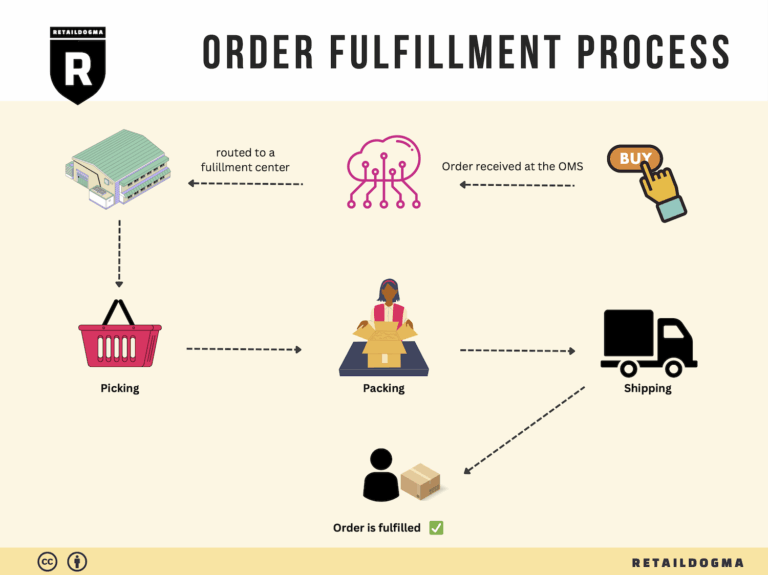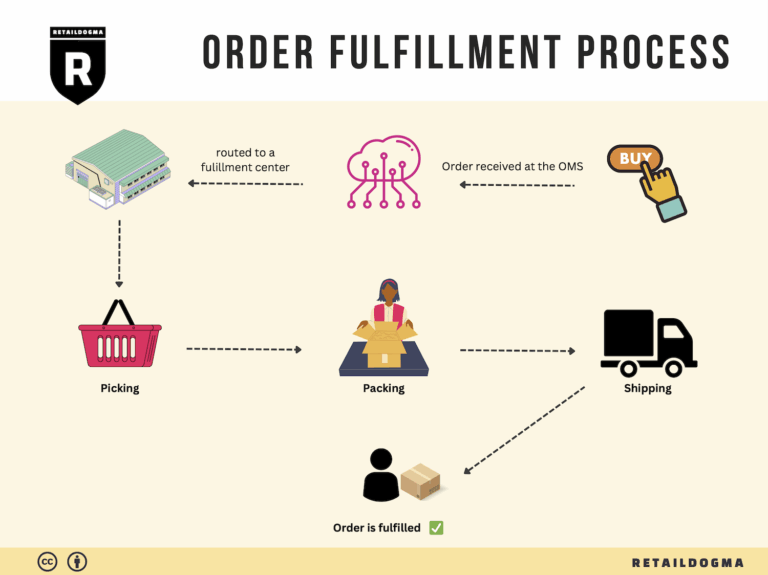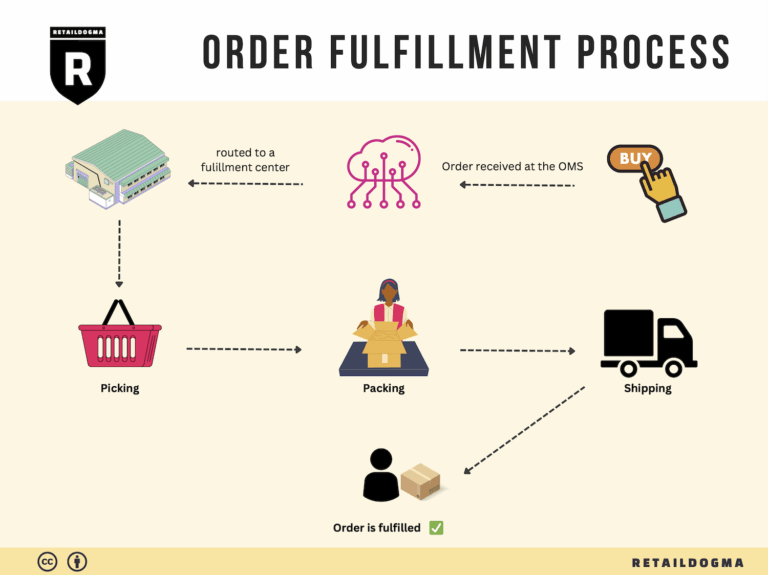What Is A Fulfillment Center? A Complete Guide (2025)
What is E-commerce Fulfillment? An Introduction for Growing Businesses
Understanding E-commerce Fulfillment
As an e-commerce business owner, you may find yourself grappling with the overwhelming tasks of packing and shipping orders, managing inventory, and ensuring timely deliveries. These logistical challenges can divert your focus from scaling your sales and enhancing your customer experience. This is where e-commerce fulfillment comes into play—defining it simply, fulfillment is the process of getting a product from your warehouse or storage to the customer’s doorstep.
E-commerce fulfillment is a critical aspect of your operations that can significantly impact customer satisfaction and your bottom line. As your business grows, so does the complexity of your logistics. Knowing when to transition from handling fulfillment in-house to utilizing external solutions can be a game-changer for your growth trajectory.
In this guide, we will explore various fulfillment models, including Third-Party Logistics (3PL) and Fulfillment by Amazon (FBA). Each model offers distinct advantages depending on your business needs, such as cost-effectiveness, speed, and scalability. We will delve into the core services offered by fulfillment partners, which typically include inventory storage, order processing, packing, and shipping. Understanding these services will help you make informed choices about which fulfillment strategy aligns best with your business goals.
Choosing the right fulfillment partner is crucial for your operational success. We will provide insights on evaluating potential partners based on factors like location, technology capabilities, and service reliability. Additionally, we will discuss pricing models commonly used in the industry, helping you understand the costs associated with different fulfillment options and how to budget accordingly.
The goal of this guide is to empower you with the knowledge necessary to make smart, strategic decisions about your logistics. By understanding the intricacies of e-commerce fulfillment, you can streamline your operations, enhance customer satisfaction, and ultimately drive your business’s growth. Whether you’re considering outsourcing fulfillment for the first time or looking to optimize your existing logistics processes, this guide will serve as a valuable resource on your journey to scaling your e-commerce business.
What You’ll Learn In This Guide
- What is E-commerce Fulfillment? An Introduction for Growing Businesses
- The Order Fulfillment Process: From ‘Buy’ Button to Customer’s Door
- Comparing Fulfillment Models: In-House vs. 3PL vs. Dropshipping
- A Deep Dive into Amazon FBA: Pros, Cons, and Who It’s For
- Core Services Offered by Fulfillment Centers
- How to Choose a Fulfillment Partner: A 6-Point Checklist
- Understanding Fulfillment Pricing: A Breakdown of Common Fees
- Frequently Asked Questions (FAQs) about Fulfillment
- Conclusion: Is Outsourcing Fulfillment the Right Move for Your Business?
- Important Disclaimer
The Order Fulfillment Process: From ‘Buy’ Button to Customer’s Door
1. Receiving Inventory
The order fulfillment process begins with receiving inventory. This step is crucial as it sets the foundation for all subsequent operations. When products arrive at the fulfillment center, they are checked against purchase orders to ensure accuracy in quantity and quality. Key terms associated with this stage include SKU (Stock Keeping Unit), which is a unique identifier for each product variant.
Proper receiving practices help to minimize errors and discrepancies that could lead to customer dissatisfaction. Effective inventory management at this stage ensures that the correct items are available for order fulfillment and helps maintain optimal stock levels, thereby preventing stockouts or overstock situations. By leveraging technologies such as barcode scanners, businesses can streamline the receiving process, improving accuracy and speed.
2. Warehouse Storage
Once inventory is received, the next step is warehouse storage. This involves strategically placing products within the fulfillment center based on demand and product characteristics. Effective storage systems utilize ABC analysis, a method that categorizes items based on their sales volume and importance. High-demand items are stored in easily accessible locations, while slower-moving stock may be placed further away.
This step is vital for operational efficiency. Properly organized storage reduces the time taken to locate products during the picking process, which directly impacts order turnaround times. Additionally, a well-structured warehouse layout can enhance safety and reduce the risk of product damage. Utilizing technology such as inventory management systems can help track stock levels in real time, further optimizing storage strategies.
3. Order Picking
The order picking phase involves selecting items from the warehouse to fulfill customer orders. This is a critical step that directly influences order accuracy and fulfillment speed. Businesses often use pick lists, which are documents or digital displays that outline the items needed for each order, including their locations in the warehouse.
Effective picking strategies, such as batch picking (picking multiple orders simultaneously) or zone picking (assigning specific areas of the warehouse to individual pickers), can significantly enhance efficiency. The accuracy of this step is paramount; errors in picking can lead to incorrect shipments, resulting in returns and customer dissatisfaction. Implementing technologies like pick-to-light systems or voice-directed picking can further streamline this process, increasing productivity and accuracy.
4. Order Packing
After items are picked, the next step is order packing. This process involves securely packaging products for shipment, ensuring they arrive at the customer’s door in perfect condition. Key considerations during packing include choosing the right packaging materials and sizes, as well as including any necessary documentation, such as invoices or return labels.
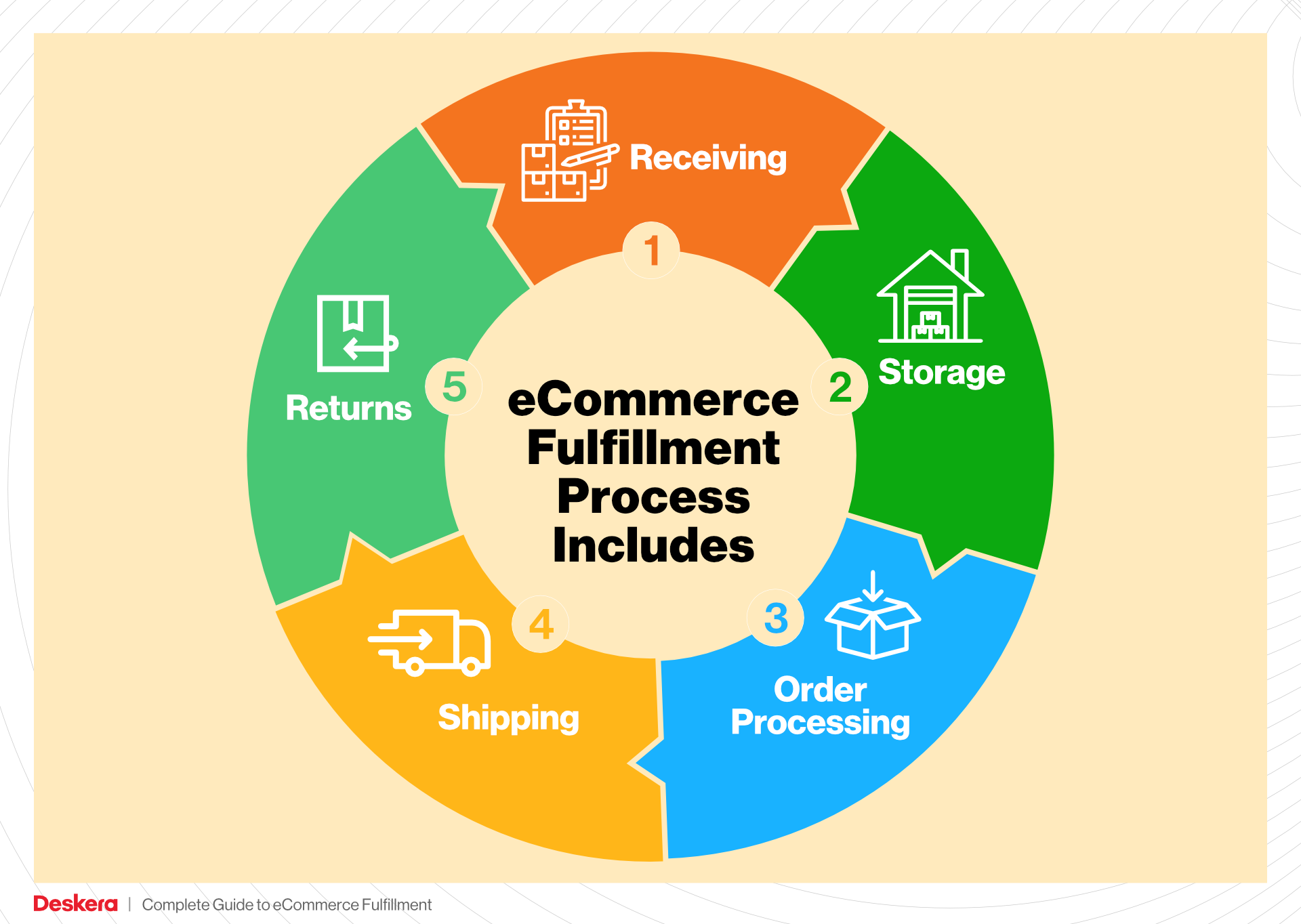
This step is essential for minimizing damage during transit and ensuring compliance with shipping regulations. Businesses often use packing slips, which detail the contents of the shipment and serve as a receipt for the customer. Efficient packing processes not only improve customer satisfaction but also reduce shipping costs by optimizing package dimensions and weight. Investing in automated packing solutions can enhance this process, allowing for faster and more accurate packing operations.
5. Shipping & Delivery
The final stage of the order fulfillment process is shipping and delivery. This involves transferring packed orders to a carrier for delivery to the customer. Businesses must select appropriate shipping methods based on factors such as cost, delivery speed, and customer preferences. Key terms in this phase include last-mile delivery, which refers to the final leg of the shipping journey from the distribution center to the customer’s location.
Efficient shipping practices are crucial for meeting customer expectations, especially for businesses utilizing services like Amazon Prime, which promises fast delivery. Tracking systems play a significant role here, allowing customers to monitor their shipments in real time. By partnering with reliable carriers and utilizing technology for logistics management, businesses can streamline their shipping processes, reduce delivery times, and enhance overall customer satisfaction.
In conclusion, each step of the order fulfillment process is interconnected and critical to the overall success of e-commerce operations. By focusing on efficiency, accuracy, and customer satisfaction at every stage, businesses can scale their operations effectively and enhance their competitive edge in the marketplace.
Comparing Fulfillment Models: In-House vs. 3PL vs. Dropshipping
Fulfillment Model Comparison
| Model | Who Handles Inventory | Best For (Business Stage) | Key Advantage | Key Disadvantage |
|---|---|---|---|---|
| In-House Fulfillment | Business itself | Established businesses with stable sales | Full control over inventory and operations | High overhead costs and complexity |
| Third-Party Logistics (3PL) | External logistics provider | Growing businesses looking to scale | Cost-effective and scalable solutions | Less control over inventory and fulfillment processes |
| Dropshipping | Supplier/vendor | Startups and small businesses | Low upfront costs and no inventory risk | Lower profit margins and potential quality control issues |
In-House Fulfillment
In-house fulfillment is a model where a business manages its own inventory and shipping processes. This model is typically best suited for established businesses with stable sales, as it requires significant investment in warehousing, staffing, and logistics infrastructure. The key advantage of in-house fulfillment is the level of control it provides over inventory management, shipping processes, and customer experience. Businesses can implement tailored solutions to meet their unique operational needs and ensure quality standards are maintained throughout the fulfillment process.
However, in-house fulfillment comes with its share of challenges. The high overhead costs associated with maintaining a warehouse, hiring staff, and managing logistics can strain cash flow, particularly for smaller businesses. Additionally, the complexity of managing inventory levels, shipping, and returns can divert focus from core business activities like marketing and product development. As a business scales, the operational demands of in-house fulfillment may become burdensome, requiring investment in additional resources or technology.
Third-Party Logistics (3PL)
Third-party logistics (3PL) involves outsourcing the fulfillment process to a specialized logistics provider. This model is particularly beneficial for growing businesses looking to scale their operations without the burden of managing logistics in-house. 3PL providers offer a range of services, including warehousing, order processing, shipping, and returns management, allowing businesses to focus on their core competencies.
The key advantage of using a 3PL is the cost-effectiveness and scalability it offers. Businesses can leverage the expertise and infrastructure of the 3PL provider, which can lead to lower shipping rates, improved delivery times, and enhanced customer satisfaction. Additionally, as businesses grow, 3PL providers can easily accommodate increased order volumes without the need for significant capital investment.
On the downside, outsourcing fulfillment can lead to less control over inventory management and shipping processes. Businesses may face challenges in maintaining brand consistency and customer experience if the 3PL provider does not align with their operational standards. Communication issues can also arise, particularly if the 3PL provider operates in a different time zone or has varying operational protocols. Businesses must choose their 3PL partner carefully to mitigate these risks and ensure a smooth fulfillment process.
Dropshipping
Dropshipping is a fulfillment model where a business sells products without holding any inventory. Instead, when a customer places an order, the business purchases the item from a third-party supplier who then ships it directly to the customer. This model is ideal for startups and small businesses, as it requires minimal upfront investment and eliminates the risk associated with inventory management.
The primary advantage of dropshipping is the low upfront costs and reduced financial risk. Entrepreneurs can launch e-commerce stores without the need to invest in inventory or warehouse space. This flexibility allows for a broader product offering without the burden of overstocking or unsold inventory. Additionally, dropshipping can enable businesses to quickly pivot and adapt their product offerings based on market trends and consumer demand.
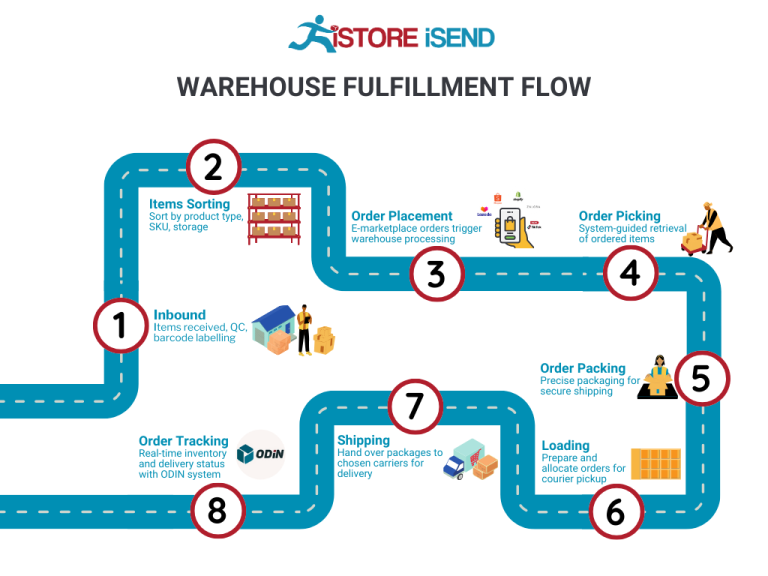
However, dropshipping also presents challenges that business owners must navigate. One significant drawback is the lower profit margins typically associated with this model. Since dropshipping relies on third-party suppliers, businesses often face higher product costs, which can squeeze margins and make it difficult to compete on price. Furthermore, quality control can become an issue, as businesses have limited oversight of the products being shipped. Delays in shipping or issues with product quality can lead to customer dissatisfaction, which can harm the business’s reputation. To succeed in dropshipping, entrepreneurs must carefully vet suppliers and maintain clear communication to ensure a positive customer experience.
Conclusion
Choosing the right fulfillment model is crucial for scaling e-commerce operations effectively. Each model—In-House Fulfillment, Third-Party Logistics, and Dropshipping—offers unique advantages and challenges. Business owners must assess their current operational capabilities, growth ambitions, and financial resources to determine the most suitable fulfillment strategy. By understanding the nuances of each model, businesses can optimize their logistics and ultimately enhance customer satisfaction, driving growth and profitability.
A Deep Dive into Amazon FBA: Pros, Cons, and Who It’s For
Understanding Fulfillment by Amazon (FBA)
Fulfillment by Amazon (FBA) is a service that allows e-commerce sellers to store their products in Amazon’s extensive network of fulfillment centers. Once a seller enrolls in FBA, Amazon takes over the storage, packaging, and shipping processes for their products. This arrangement enables sellers to leverage Amazon’s vast logistics infrastructure, including its advanced technology and customer service capabilities, to reach millions of customers worldwide.
How FBA Works
-
Product Preparation and Shipment: Sellers prepare their products according to Amazon’s guidelines and ship them to designated fulfillment centers. Amazon provides specific labeling and packaging requirements to ensure smooth processing.
-
Storage: Once the products arrive at the fulfillment center, they are stored until a customer places an order. Amazon uses sophisticated inventory management systems to track products and manage stock levels.
-
Order Processing: When a customer orders a product, Amazon picks, packs, and ships the item on behalf of the seller. This process is highly automated, using advanced robotics and technology to ensure efficiency and accuracy.
-
Customer Service and Returns: Amazon also handles customer service inquiries related to FBA orders, including returns and refunds, which can significantly relieve sellers of operational burdens.
-
Prime Eligibility: Products fulfilled through FBA are automatically eligible for Amazon Prime, which offers customers fast, free shipping options. This enhances the attractiveness of FBA products to the millions of Prime members.
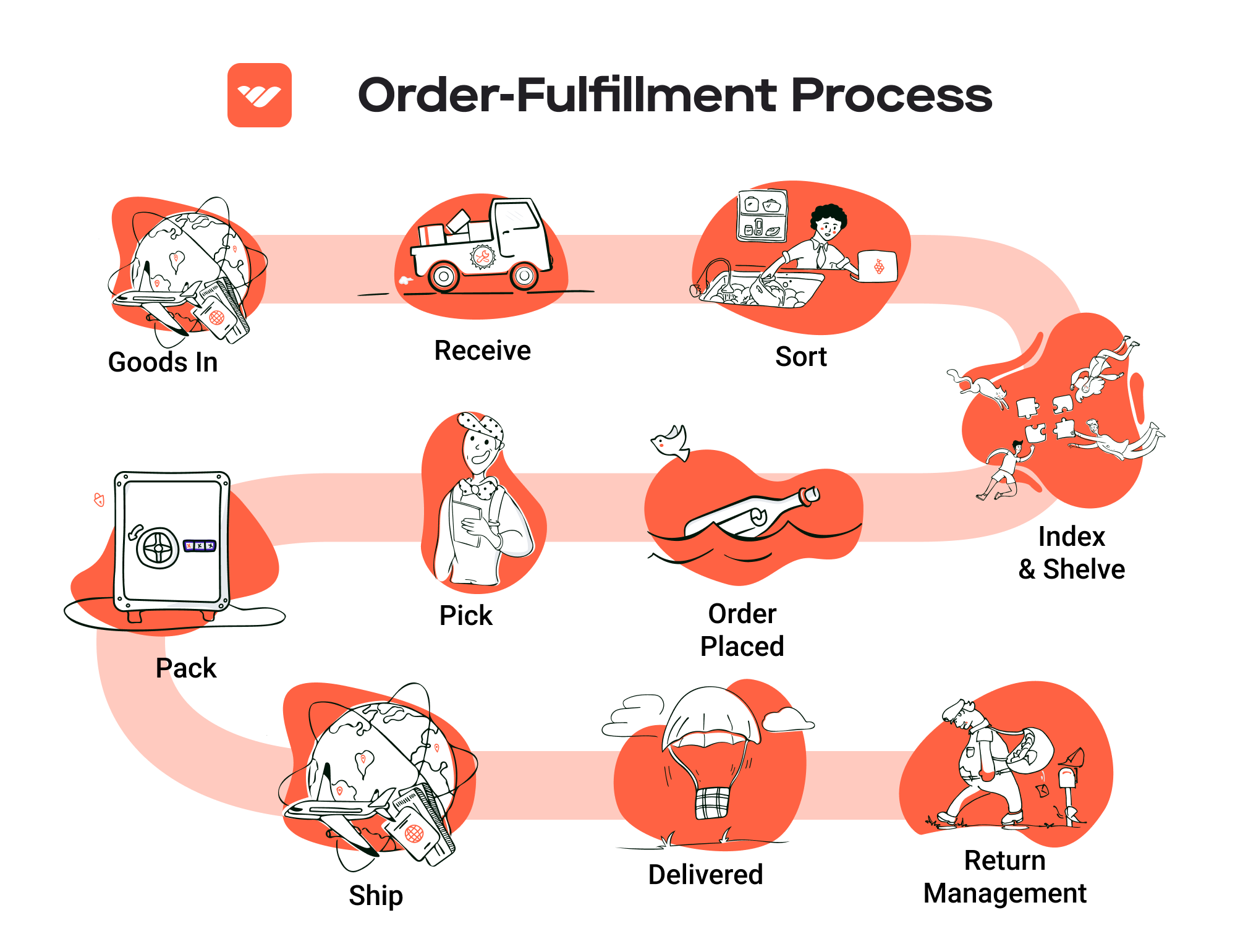
Pros of FBA
1. Prime Eligibility
One of the most significant advantages of FBA is that products become eligible for Amazon Prime. This is a major selling point, as Prime members are known to spend more and are often more loyal to sellers offering Prime shipping.
2. Customer Trust
By utilizing FBA, sellers benefit from Amazon’s trusted brand. Customers are more likely to purchase products fulfilled by Amazon due to the assurance of reliable shipping, customer service, and return policies. This trust can lead to higher conversion rates and repeat purchases.
3. Multi-Channel Fulfillment
FBA isn’t limited to Amazon.com. Sellers can also use FBA to fulfill orders from other sales channels, including their own e-commerce websites and other marketplaces. This flexibility can streamline operations and enhance overall logistics efficiency.
4. Reduced Operational Burden
Sellers can focus on growing their business rather than managing logistics. Amazon handles inventory storage, order processing, shipping, and customer service, allowing sellers to dedicate more time to marketing and product development.
5. Scalability
FBA allows businesses to scale without the need for significant investment in warehousing and logistics infrastructure. As demand increases, sellers can easily send more inventory to Amazon’s fulfillment centers.
Cons of FBA
1. High Fees
FBA is not without costs. Sellers must pay various fees, including storage fees for inventory held in Amazon’s warehouses and fulfillment fees for each order processed. These costs can accumulate quickly, particularly for low-margin products.
2. Strict Inventory Rules
Amazon has strict guidelines regarding inventory management. Sellers must adhere to these policies to avoid penalties, including removal of inventory or additional fees. This can be challenging for sellers who manage multiple products or experience fluctuating demand.
3. Commingling Risks
FBA products are often commingled, meaning that inventory from different sellers may be stored together. This can lead to issues if customers receive products that are not from the seller they ordered from, potentially affecting brand reputation and trust.
4. Limited Control Over Shipping
While Amazon’s logistics capabilities are robust, sellers have limited control over shipping times and methods. This can be a concern for sellers who want to ensure a specific customer experience or need to manage shipping costs tightly.
5. Dependency on Amazon
By choosing FBA, sellers become reliant on Amazon’s policies and infrastructure. Any changes in Amazon’s rules, fees, or logistics processes can significantly impact sellers’ operations and profitability.
Who is FBA Best For?
Fulfillment by Amazon is particularly beneficial for small to medium-sized e-commerce businesses looking to scale rapidly without investing heavily in logistics. It suits:
- New Sellers: Those who are just starting and want to take advantage of Amazon’s vast customer base and logistics capabilities.
- High-Volume Sellers: Businesses that experience high sales volume and need to streamline fulfillment processes to keep up with demand.
- Retail Brands: Established brands that want to expand their reach without the complexity of managing their own fulfillment networks.
- Multi-Channel Sellers: E-commerce businesses selling on multiple platforms looking for a unified fulfillment solution.
In conclusion, while FBA offers numerous advantages that can help businesses scale efficiently, it is essential for sellers to weigh these benefits against the potential downsides. Understanding the intricacies of FBA can empower sellers to make informed decisions that align with their business goals and operational capabilities.
Core Services Offered by Fulfillment Centers
Inventory Management & Warehousing
Inventory management and warehousing are foundational services provided by fulfillment centers. This involves the systematic tracking of inventory levels, orders, sales, and deliveries. Fulfillment centers utilize advanced software systems to manage stock efficiently, ensuring that e-commerce businesses have real-time visibility into their inventory status.
The benefits of robust inventory management are significant for e-commerce businesses. First, it minimizes the risk of overstocking or understocking, both of which can lead to lost sales or excess holding costs. By leveraging data analytics, fulfillment centers can forecast demand more accurately, allowing businesses to align their inventory levels with market trends. This can result in improved cash flow, as funds are not unnecessarily tied up in unsold products. Furthermore, effective warehousing ensures that products are stored under optimal conditions, reducing the risk of damage and spoilage.
Pick and Pack Services
Pick and pack services are critical to the fulfillment process, encompassing the picking of ordered items from the warehouse shelves and packing them for shipment. Fulfillment centers employ a systematic approach to this process, often using technology such as barcode scanning and automated picking systems to enhance accuracy and efficiency.
The main advantage of pick and pack services is the speed and precision they bring to order fulfillment. In today’s fast-paced e-commerce environment, consumers expect quick delivery times. Fulfillment centers can process orders rapidly, often shipping them within hours of placement. This capability not only improves customer satisfaction but also enhances the seller’s reputation. Additionally, efficient packing reduces shipping costs by ensuring optimal use of space and materials, which can lead to better profit margins for e-commerce businesses.
Kitting and Assembly
Kitting and assembly services involve bundling individual items together into ready-to-sell packages, or assembling products as required. This service is particularly beneficial for businesses that sell products that are often purchased together or require assembly before they can be sold.
The primary benefit of kitting and assembly is the convenience it provides to both the seller and the consumer. For e-commerce businesses, it simplifies inventory management by reducing the number of SKUs (stock-keeping units) they need to manage. By offering bundled products, sellers can also increase their average order value, as customers are often enticed to purchase more items when they see them packaged together. Additionally, pre-assembled products can enhance the customer experience by saving them time and effort, thereby improving overall satisfaction and loyalty.
Returns Management (Reverse Logistics)
Returns management, or reverse logistics, is a crucial service provided by fulfillment centers that involves handling returned products efficiently. This service encompasses the entire process of returning items, from receiving returns at the fulfillment center to inspecting, restocking, or disposing of them as necessary.
Effective returns management is essential for maintaining customer satisfaction and loyalty. A streamlined returns process can significantly enhance the shopping experience, as consumers are more likely to make a purchase if they know they can easily return items if needed. Fulfillment centers often employ sophisticated return tracking systems to ensure that returned items are processed quickly and accurately, minimizing downtime and potential losses for the e-commerce business. Moreover, insights gained from return data can help businesses identify issues with product quality or descriptions, enabling them to make necessary adjustments to reduce future returns.
In summary, fulfillment centers offer a suite of core services that are invaluable for scaling e-commerce businesses. By effectively managing inventory, streamlining order fulfillment through pick and pack services, providing kitting and assembly solutions, and efficiently handling returns, fulfillment centers empower businesses to operate more effectively and enhance customer satisfaction. Leveraging these services allows e-commerce businesses to focus on their core competencies, such as marketing and product development, while leaving the complexities of logistics and fulfillment to the experts.
How to Choose a Fulfillment Partner: A 6-Point Checklist
Location & Warehouse Network
Importance:
The geographical location of your fulfillment partner’s warehouses is critical for optimizing shipping times and costs. A strategically placed fulfillment center can significantly reduce transit times to your customers, enhancing overall satisfaction.
Questions to Ask:
– Where are your fulfillment centers located, and how do they align with my target markets?
– What is your average shipping time to key locations?
– How do you handle logistics for international shipping if my customer base expands?
Technology & Integrations
Importance:
In today’s e-commerce landscape, efficient fulfillment relies heavily on technology. A good fulfillment partner should offer robust systems that integrate seamlessly with your existing platforms (like Shopify, Amazon, etc.) to ensure real-time inventory tracking, order management, and reporting.
Questions to Ask:
– What technology platforms do you use for inventory management and order processing?
– Can your system integrate with my current e-commerce platform?
– How do you handle data security and privacy for my customer information?
Specializations (e.g., Cold Storage, Oversized Items)
Importance:
Different businesses have unique needs based on the nature of their products. If you sell perishable goods, for instance, a partner with cold storage capabilities is essential. Similarly, if you deal with oversized or fragile items, ensure your partner has the necessary equipment and expertise.
Questions to Ask:
– What special services do you offer that cater to my product type (e.g., cold storage, kitting, or assembly)?
– Can you handle items that require special handling or storage conditions?
– What experience do you have with businesses in my industry?
Scalability & Capacity
Importance:
As your business grows, your fulfillment partner must be able to scale with you. This includes having the capacity to handle increased order volumes and the ability to adapt to seasonal fluctuations.
Questions to Ask:
– What is your current capacity, and how do you plan to scale as my business grows?
– How do you manage peak seasons (e.g., holidays, sales events) in terms of staffing and inventory?
– Are there any limitations on the types or quantities of products you can handle?
Pricing and Contracts
Importance:
Understanding the pricing structure is essential to avoid unexpected costs that could impact your profitability. Transparency in pricing and contract terms will help ensure a good partnership.
Questions to Ask:
– What is your pricing model (e.g., per order, per item, storage fees)?
– Are there any additional fees I should be aware of (e.g., handling, returns, or packaging)?
– What are the terms of the contract, and is there flexibility for renegotiation as my business needs change?
Customer Support & Reviews
Importance:
Reliable customer support is crucial for resolving issues quickly, especially during peak times. Additionally, reviews and testimonials from other businesses can provide valuable insights into the partner’s reliability and service quality.
Questions to Ask:
– What kind of customer support do you offer (e.g., dedicated account manager, 24/7 support)?
– Can you provide references or case studies from similar businesses?
– How do you handle issues or disputes with clients, and what is your process for communication?
By utilizing this checklist, e-commerce business owners, operations managers, and entrepreneurs can methodically evaluate potential fulfillment partners. Each point addresses crucial aspects of a partnership that can significantly impact your business’s efficiency and customer satisfaction.
Understanding Fulfillment Pricing: A Breakdown of Common Fees
Initial Setup Fees
When you first engage with a fulfillment center, you may encounter initial setup fees. These fees cover the cost of onboarding your products into the fulfillment system. This process typically includes creating your seller account, setting up your product listings, and integrating your inventory management system with the fulfillment center’s software.
The calculation of initial setup fees can vary significantly based on the complexity of your inventory and the specific services provided by the fulfillment center. Basic setups might incur a nominal fee, while more intricate setups that require custom integrations or a large volume of SKUs may cost more. It’s essential to clarify what is included in these fees, as some centers may offer bundled services that reduce overall costs.
Receiving Fees
Receiving fees are charged each time your products are sent to the fulfillment center. This fee compensates the warehouse for unloading, inspecting, and processing your inventory. The receiving process typically involves checking the quantities against the shipping manifest, inspecting for damages, and entering the products into the inventory management system.
Receiving fees are usually calculated based on the number of units received or the total weight of the shipment. For example, some centers may charge a flat rate per pallet, while others may charge per item. Understanding the receiving fees upfront can help you budget more accurately for incoming shipments.
Storage Fees (per pallet/bin)
Storage fees are incurred for the space your inventory occupies in the fulfillment center. These fees are typically calculated on a per pallet or per bin basis, with costs varying depending on the duration of storage. Most fulfillment centers have different pricing tiers for short-term and long-term storage, often defined as storage beyond a certain number of days (e.g., 30 days).
For example, if your products are stored in a pallet racking system, you might be charged a monthly fee for each pallet. Alternatively, if you utilize bin storage, the fee may be based on the number of bins your products occupy. Long-term storage fees can significantly increase your costs, so it’s crucial to monitor your inventory levels and turnover rates to minimize these expenses.
Pick & Pack Fees (per item/order)
Pick and pack fees are charged for the labor involved in retrieving items from storage and preparing them for shipment. This process includes picking the correct items, packing them securely, and labeling the packages for shipping.
These fees are generally calculated on a per item or per order basis. For instance, a fulfillment center might charge a flat fee for picking a single item, with an additional fee for each additional item in the same order. Some centers may offer tiered pricing based on order volume, which can be beneficial for businesses with high order quantities. Understanding this fee structure allows you to optimize your order fulfillment processes and reduce costs.
Shipping Fees
Shipping fees are one of the most significant components of fulfillment costs. These fees cover the expense of transporting your products from the fulfillment center to the customer. Shipping costs can vary based on several factors, including the destination, weight, dimensions of the package, and the shipping method selected (e.g., standard, expedited).
Many fulfillment centers leverage partnerships with major carriers, which can lead to discounted shipping rates. It’s vital to compare shipping fees across different fulfillment centers to identify the most cost-effective options for your business. Additionally, consider negotiating rates based on your shipping volume, as many centers are open to adjusting fees for high-volume shippers.
Tips for Getting an Accurate Quote
To ensure you receive an accurate quote from a fulfillment center, consider the following tips:
-
Provide Detailed Information: Share comprehensive details about your product types, dimensions, weight, and anticipated order volumes. The more information you provide, the more accurate the pricing will be.
-
Ask About All Fees: Inquire about all potential fees, including hidden costs that may not be immediately apparent. This includes setup, receiving, storage, pick and pack, and shipping fees.
-
Request Examples: Ask for sample quotes based on realistic scenarios reflective of your business operations. This will help you understand how fees scale with order volume and product variety.
-
Negotiate Terms: Don’t hesitate to negotiate fees, especially if you expect a high volume of orders. Many fulfillment centers are willing to offer discounts for long-term contracts or larger order quantities.
-
Review Contracts Carefully: Before signing any agreements, carefully review the terms and conditions related to fees. Ensure there are no unexpected clauses that could lead to additional costs.
By understanding these common fulfillment pricing models and actively engaging with fulfillment centers, you can better manage your logistics costs and enhance your overall operational efficiency.
Frequently Asked Questions (FAQs) about Fulfillment
1. What is Amazon Fulfillment Center DAB2?
Amazon Fulfillment Center DAB2 is a state-of-the-art, robotic distribution facility located in Daytona Beach, Florida. Covering approximately 2.8 million square feet, it is designed to streamline the storage, processing, and shipping of products for Amazon’s vast network of sellers. The center utilizes advanced automation technology to enhance efficiency and speed in order fulfillment.
2. How does the fulfillment process work at DAB2?
At DAB2, the fulfillment process begins when products are received and stored in the facility. When an order is placed, automated systems pick and pack the items for shipment. The orders are then sorted and dispatched to various carriers for delivery to customers. This automated process allows for faster turnaround times, often meeting the two-day shipping promise for Prime members.
3. What is the difference between a warehouse and a fulfillment center?
A warehouse is primarily a storage space for goods, while a fulfillment center is specifically designed to handle the entire order processing workflow, from storage to packing to shipping. Fulfillment centers like DAB2 focus on quick order turnaround and customer service, integrating logistics and technology to optimize the shipping process.
4. What is a 3PL (Third-Party Logistics)?
A 3PL, or third-party logistics provider, is a company that offers logistics services to businesses, including warehousing, transportation, and order fulfillment. By partnering with a 3PL, businesses can leverage the provider’s infrastructure and expertise to streamline their supply chain operations without having to invest in their own logistics capabilities.
5. How much do fulfillment services cost?
Fulfillment service costs can vary widely based on several factors, including the size of your inventory, order volume, and specific services required (like packaging or kitting). Generally, costs may include storage fees, picking and packing fees, shipping fees, and any additional services. It is advisable to request quotes from different fulfillment centers to compare pricing and services.
6. What types of products can be stored and fulfilled at DAB2?
DAB2 is capable of handling a wide variety of products, from consumer electronics and clothing to household items and health products. However, certain restrictions may apply, particularly for hazardous materials or perishable goods. It’s important to check Amazon’s guidelines for specific product categories before utilizing the facility.
7. How does DAB2 support sellers using Fulfillment by Amazon (FBA)?
DAB2 supports sellers by providing them access to Amazon’s extensive logistics network and customer service resources. By using FBA, sellers can store their products at DAB2, allowing Amazon to handle the picking, packing, and shipping of orders. This enables sellers to offer Prime shipping and increases their visibility on the Amazon platform.
8. What are the advantages of using DAB2 for order fulfillment?
Using DAB2 for order fulfillment offers numerous advantages, including:
– Speed: Automated systems allow for rapid order processing and shipping.
– Scalability: As your business grows, DAB2 can accommodate increased order volumes without the need for additional infrastructure.
– Cost-effectiveness: By leveraging Amazon’s network, sellers can reduce shipping costs and improve delivery times.
– Customer service: Amazon’s established customer service framework enhances the buying experience for end customers.
9. How can businesses track their inventory at DAB2?
Businesses can track their inventory stored at DAB2 through Amazon’s Seller Central platform. This platform provides real-time data on inventory levels, order status, and shipping information, allowing sellers to manage their stock effectively and make informed decisions about restocking and order fulfillment.
10. What are the hiring opportunities at DAB2?
DAB2 is expected to create approximately 1,000 jobs, ranging from warehouse associates to specialized positions in robotics and maintenance. Amazon regularly posts job openings on its careers page, and candidates interested in working at DAB2 should check these listings for available positions and application details.
Conclusion: Is Outsourcing Fulfillment the Right Move for Your Business?
Evaluating the Benefits of Outsourcing Fulfillment
Outsourcing fulfillment can be a transformative strategy for e-commerce businesses seeking to scale effectively. One of the primary benefits is time savings. By leveraging a fulfillment service, business owners can shift their focus from logistics to core activities such as product development and marketing. This transition allows for a more strategic allocation of resources, enabling teams to innovate and grow their brand without being bogged down by operational complexities.
Scalability is another significant advantage. As your sales increase, so do the demands on your fulfillment processes. Partnering with a fulfillment service can provide the infrastructure needed to manage larger order volumes seamlessly. With the right partner, you can easily scale your operations up or down in response to market fluctuations, ensuring you remain agile in a competitive landscape.
Moreover, fulfillment services often come equipped with specialized expertise and technology. Facilities like Amazon’s state-of-the-art distribution centers utilize advanced robotics and logistics systems that can enhance efficiency and accuracy in order processing. This level of expertise can be challenging to replicate in-house, especially for small to mid-sized businesses.
Choosing the Right Partner for Growth
However, the effectiveness of outsourcing fulfillment hinges on selecting the right partner. It’s essential to assess potential fulfillment services based on their operational capabilities, technology, customer service, and alignment with your business goals. A mismatch can lead to operational inefficiencies and negatively impact customer satisfaction.
Strategic Call-to-Action
To determine if outsourcing fulfillment is the right move for your business, conduct a thorough audit of your current shipping and logistics processes. Analyze order fulfillment times, costs, and customer feedback. This evaluation will provide insights into whether a fulfillment partner can enhance your operational efficiency and support your growth objectives. Take the next step—investigate potential fulfillment partners and explore how they can contribute to your business success.
Important Disclaimer
⚠️ Important Disclaimer
The information in this guide is for educational purposes. Fulfillment services, pricing, and platform features change frequently. Always conduct your own due diligence and consult with providers directly before making business decisions.
